SOUTH AFRICA Richards Bay to Knysna - A high-risk passage
Destination - Indian OceanOur adventurer Olivier Mesnier is back at sea after a long four-week stopover on the island of La Réunion. He and his crew are heading for South Africa, with its strong currents and legendary waves... On the menu for this crossing was a gale as brutal as it was unpredictable.
On board Jangada, there was a back-toschool atmosphere for the crew. It was back to the business of sailing around the world! Tomorrow, we would be leaving for South Africa, via the south of Madagascar. Given the sluggishness of the maneuvers, I realized that our minds were still ashore. Jangada was snorting. Her hulls were dirty after four weeks along-side the dock. She too has to get back to work, out on the ocean. We were bound for Richards Bay, South Africa, 85 miles north of Durban, and 1,356 miles from Reunion Island. A large bulk commercial port, which has the advantage of being located inside a well-protected lagoon. It is home to a reputedly friendly yacht-club, the Zululand Yacht-Club. On our way is the southern continental shelf of Madagascar, which has a bad reputation. It’s a zone where the winds accelerate, coming from opposing directions, over shallow depths, with the swell generated by the depressions of the Roaring Forties, which succeed one another to the south.
On the third day at sea, the memories of our last days on Reunion Island slowly faded away. An immaculate white strawtail came flying over us. It is curious how this bird, which seems at first sight to be a poor flyer with its jerky, insecure flight, is in fact able to live far from land, out on the open sea.
First stop: Richards Bay
On the 8th day of the crossing, we still had a good fifty miles to go as the pale sun set, which meant an arrival in the depths of the night. A few hours earlier, the electronic barometer had sounded its alarm for a rapid drop in atmospheric pressure, a sign that we were heading straight into the depression located on Richards Bay... I didn’t feel like hanging around at sea, at the risk of getting hammered by 35 knots of wind just 30 miles from the finish. Speed 10/11 knots, salty spray and a choppy sea. I decided not to slow down. At 03.00, we passed the breakwaters. The full moon was playing hide and seek with the clouds, running low in the sky. Suddenly, the calm of the river, the red and green buoys, the scent of wet earth, the smell of mud. This is the magic of arriving by sea, as travelers, in a country we do not know. At dawn there was a surprise for us: monkeys everywhere on the quay and on the surrounding roofs too! They get on the sailboats, inhabited or not, and sneak inside, preferably on those whose companionways or saloon doors have been left open. They then come out with a packet of cookies, a bag of chips or a stolen pineapple, settle down in the cockpits, and quietly start eating... After the customs formalities, we left Tuzi Gazi for the small river of the Zululand Yacht Club. We found a good spot, right next to a green park, a small swimming pool and a small beach. We were almost at the end of our Indian Ocean adventure…

The entrance pass to Knysna harbor, in good weather. In the center, you can see Emu Rock, which must be avoided. In spite of appearances, this pass is classified in the top 10 of the most dangerous passes in the world...
The dangers of the South African coasts
After two weeks of contrasting stopovers and much speculating on the evolution of the weather situation, we left one of the most pleasant yacht-clubs that we had encountered during our trip. We first headed south-east to take advantage of the Agulhas current. Our objective was simple: to take advantage of this weather window that we had been waiting several days for to go as far as possible towards the west along the South African coast, avoiding rough seas as much as possible and trying not to put ourselves in danger.
You maybe didn’t know it, but the most famous cape of Southern Africa is not the southernmost point of the African continent. This extreme position in latitude is occupied by the Cape of Agulhas (34°50’South), located about 80 miles south-east of the Cape of Good Hope (34°22 South). It is therefore the Cape Agulhas which geographically delimits the southern end of Africa, and which differentiates the Indian Ocean from the Atlantic Ocean. Reaching Cape Agulhas from Richards Bay represents a minimum of 758 miles of sailing. Between these two points one can encounter any of the known dangers of the South African coasts: rapidly changing weather, weather predictions often contradicted by the influence of local phenomena, passage of powerful and brief weather fronts, strong Agulhas current bearing south-west with veins of countercurrent to the coast, possibility of rapid formation (a few tens of minutes) of very big seas with abnormally high and breaking waves if a sustained south-westerly wind confronts the main current, etc...
Between Durban and the small port of East London, no shelter is possible along 250 nm of shoreline. This part of the South African coast is probably the most delicate to negotiate, partly because of this fact, but also because weather forecasts are particularly difficult. The weather was overcast with weak light. The sky was low. Ugly, moody, dark clouds rolled around in a threatening sky. In the early afternoon, the GPS was showing higher and higher speeds. We were hitting about ten knots over the water, but the GPS was increasingly showing 12, 13 and even 14 knots. That’s it, we had hitched a ride on the Agulhas current conveyor belt! Our hourly average speed was now eating up the miles. But a surprise awaited beyond the next wave…
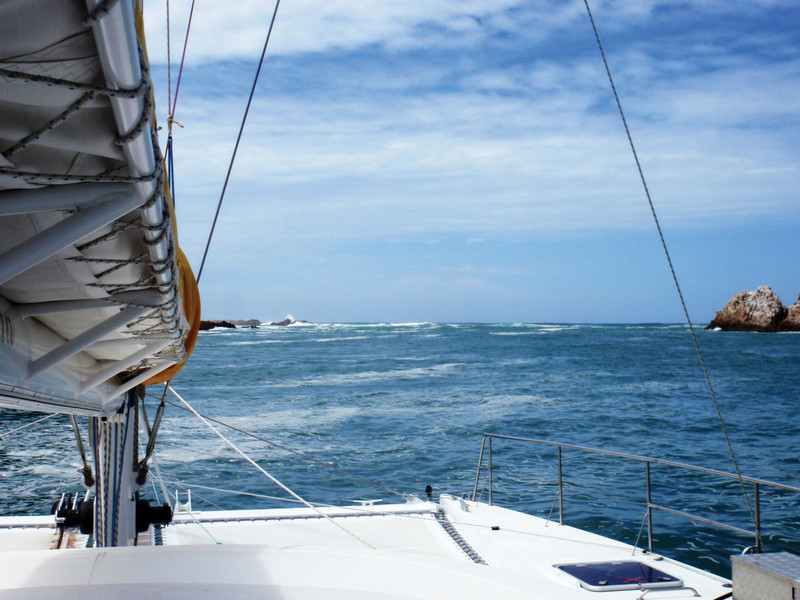
Going through the Knysna pass. The golden rule: wait for favorable conditions to avoid get-ting caught in the breakers...
Third reef in the main and solent furled up
The night of November 27th to 28th, the end of the austral spring, will stay etched in my memory... Here, the Agulhas current reaches its maximum speed, sometimes 5 to 6 knots. I estimated it at 3 or 4 knots during our passage. Apart from the probable presence of a few thundery squalls, which I had seen on the weather chart, nothing could predict the power of what was going to fall on us in the darkness of the night. We knew that a small, relatively stormy depression (1,008 millibars as against around 1,020) had been stagnating for a few days along the coast. It was disrupting the weather forecast that was dominated by two large anticyclonic zones that were almost touching each other in the region of Mossel Bay, a little east of Cape Agulhas. We had already noticed from the start that the north-easterly wind initially forecast on our route at 15/20 knots was blowing more in the 25/30 knot range, gusting to 35. However, there was nothing that got too bad in the afternoon and evening of the 27th. The cockpit thermometer was reading 64 to 68°F (18 to 20°C), but the sea temperature had dropped a lot.
We had gone from 73°F (23° C) in Richards Bay to 62/64°F (17/18° C) abeam of East London. In the afternoon, a surf at just over 20 knots had impressed 13-year-old Marin, who had since wished that things would calm down for the night. I was in the same frame of mind as my son. We had been gradually forced to reduce the sail area in the evening, as the squalls were gusting to over 35 knots. The GPS continued to show steady speeds of 12 to 14 knots, despite the 3rd reef taken in the mainsail at around 10:30 pm. Visibility was too bad for the East London light halo to reach us. Around midnight, we did a few surfs at 16 or 17 knots. Not particularly reassuring on a pitch-black night and I decided to completely furl the solent. We still maintained a steady speed of 10/12 knots, which was sufficient to eat up the miles. We had passed several cargo ships at close range during the day and into the evening, and I was regularly checking our little radar, congratulating myself for having repaired it on Reunion Island, although it was diffi-cult to read it due to its struggling in these difficult conditions. The officer of the watch on the container ship MSC Melissa, with whom I had had a little chat on VHF, had wished us a good night... He was on his way from Port Elizabeth to Durban. Around 03.00 in the morning, Marin was sleeping as well as he could on the port side bench of the saloon while I tried to dry my hair and face, as each of my short walkarounds outside was soaking me generously. That was when the serious weather hostilities really started to kick in...
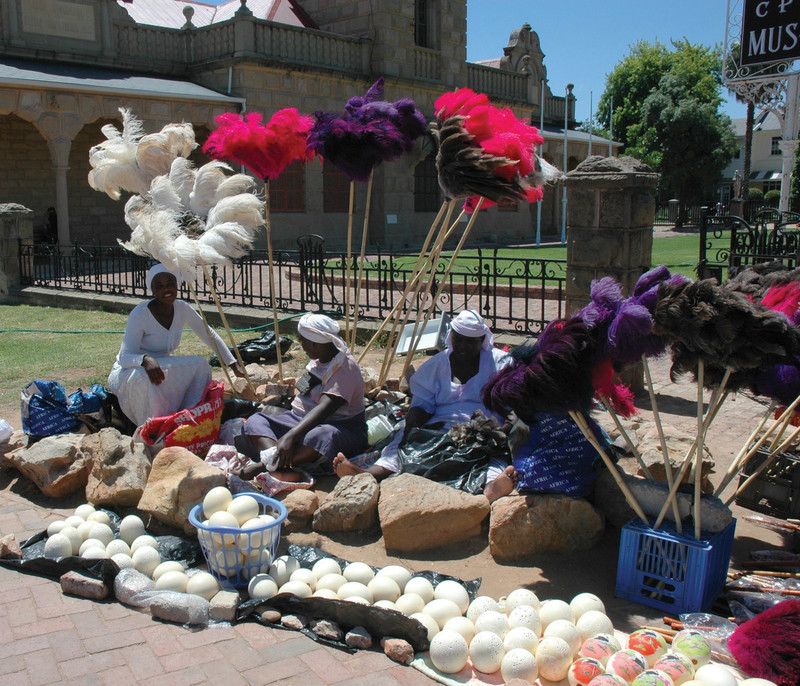
Ostrich feather sellers in the Oudtshoorn area.
Keep maneuvering: cargo ships are still at sea ...
The night was dark, and the bad weather probably reduced visibility to only a few hundred yards. There was no warning sign of the phenomenon, but in just a few seconds, the wind really started to pick up. At 40 knots it started whistling through the shrouds and the open aft end of the boom began to sing the song of bad weather days. The shrouds began to vi-brate. It was the familiar refrain of the «big storm». The wind immediately climbed to 45 knots, which was really quite something, but I reassured myself that it was not going to last. After all, it must have been a squall. Too late to drop the main already with three reefs: the pressure on the canvas was already too strong, the cars would not have come down along their luff track and we would have had to start the engines, come upwind, release the halyard, tame the flogging canvas, and seriously lash the sail, before running un-der bare poles. I then considered, in the hindsight of squalls, that there was more risk in trying to drop the sail too late, than in trying to manage the risk with the deepest reef al-ready set. I wanted to maintain a minimum maneuvering potential because of the presence of cargo ships. The wind increased again and was now at 50 knots. It was howling through the rigging. I realized that it had veered violently to the southeast with the first gusts. At 45° off the wind, the boat, although under autopilot, turned herself towards the cape, going upwind under the thrust of the mainsail. The chop and sea spray began to wash over the deck. I decided to ignore this as it was a question of natural balance which was not necessarily a bad thing. I just started the engines and left them idling, but for the first time since the beginning of the trip, I didn’t hear them. The regular humming of the Volvos was totally drowned out by nature’s angry growling. It was Wagneresque. I had to read the engine dials to make sure they had started properly. The anemometer now indicated more than 55 knots. Suddenly, water was pouring down on us, like being beneath a waterfall. Hundreds of gallons, thousands in total. In the glow of my headlight, I could no longer see six feet in front of me.
Very quickly, the generously dimensioned gutters of the coachroof proved to be insufficient to evacuate this incredible quantity of water that had fallen from the sky. Not for reasons of adequacy of evacuation diameters, but more that this mass of water tended to oscillate on deck without necessarily finding its way quickly back to the sea. There was about four inches (10cm) of water on the deck, which swished from one side to the other depending upon the movements of the boat. Everything was soaked, so I took refuge inside, at the navigation station, and closed the door. The water came over the threshold. There was nothing to do but wait, hoping that, as is usually the case, the squall would quickly run out of steam. But one thing worried me and made me think that we were dealing with a truly violent, exceptional phenomenon. Usually, in most squalls, the strongest wind gusts are experienced at the beginning of the chronological cycle of the squall’s passage. And then when the rain comes down on you, sometimes violently, the wind immediately loses strength. Then you know that the hardest part is over. Perhaps not the most uncomfortable, but the most violent. But that was not the case here. In spite of these downpours, the wind continued to climb. Marin shouted to me in an anxious voice that he was reading 60 knots on the anemometer at the chart table. I tried to reassure him, but to tell the truth I was not completely reassured myself. How strong was the wind going to blow? And how long would it last?
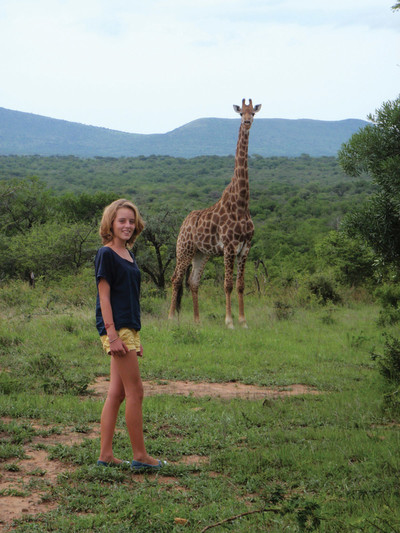
Near Richards Bay, the Hluhluwe-Imfolozi Wildlife Reserve and Kwazulu-Natal Park are worth a visit.
Four ready-to-use TPS survival suits
I thought of our four TPS survival suits, stored in the starboard hull, under the berth where Adélie and her mother were taking refuge. They weren’t really necessary yet, but I knew from experience (mainly gained in polar regions) that when you put them on, you feel better protected, more able to face the raging natural elements and any possible disaster. In short, you feel stronger. Otherwise, cold and humidity can quickly erode your morale. I was beginning to think that the time seemed right to put them on, although I wish I could have done it sooner. But this powerful squall had hit us unexpectedly. We hadn’t seen it coming, let alone guessed its violence. The darkness was total. The radar screen was totally cluttered with squalls that appeared very dense on the 12-mile scale. I rushed to the starboard side-deck, opened the companionway door, and yelled at the girls to see if everything was okay. I heard that they shouted a positive answer, and I just replied in the same positive tone of voice that we were in a strong squall, that it was not going to last, that we had to hold on and wait. Then I closed the double door and locked it with its latches. I came running back into the saloon, grabbed my towel, already dripping with cold water, and looked at the anemometer: it was steady at 65 knots! The sea state, which was getting worse by the minute, was beginning to worry me. The slope of the waves was getting steeper and steeper, the waves were breaking more and more frequently, and the deck was being submerged by the waves more often. I told myself that we had done well thus far, but that we had had enough. I began to shout out: - «That’s enough now! I hope you’re going to stop?”
I knew myself. This was the physical manifestation of the of the apprehension that was welling up in me. I was concerned about the duration of the phenomenon and the force that the wind was going to reach. I was thinking of my family, who I had taken on the adventure of the round-the-world trip. Bringing everyone back to La Rochelle was the promise I had made to myself. No other possibility was an option. Violent flashes of lightning barred our very modest horizon at close range, but the din of the wind was such that the rumble of thunder did not even reach us. I had already experienced lightning several times on sailing boats, and I was well aware of the extent of the damage it could cause. It was hard not to think about it. I crossed my fingers... The leech of the mainsail was flogging hard despite the tension of the sheet, I was worried about the rigging and the sail, and at the same time I told myself that with so little canvas, the hits couldn’t be that powerful. The breaking waves that were starting to explode on the port bow worried me more. I concentrated my attention on the boat’s behavior, thinking that if the situation worsened, I might have to consider turning back, to flee from the wind and the sea, even if it meant going against the current, and getting closer to the coast. But the catamaran didn’t move much. We just took a beating from the waves that hit us from the port bow. We were being rinsed copiously, but nothing, for the moment, was truly alarming. Except the uncertainty we were in regarding the duration of the fight. I only regretted not having been able to anticipate the arrival of this powerful squall, and having kept the mainsail at 3 reefs. I also regretted not having had time to put on the survival suits before the arrival of the strong wind. I was happy to have a solid catamaran beneath my feet whose displacement was not particularly light, and which had good stability. Marin was tense, I could read the worry on his youthful face. I was trying to joke, telling him that it would give him one more memory to tell his buddies and that the girls of La Rochelle would take him for a hero when he came back, asking him to tell them again and again about his adventures sailing around the world... But I had to admit that it didn’t make him laugh. For my part, I was attentive to the slightest sign in this commotion, and I tried to reassure myself by repeating that apparently, according to the radar screen, there was no cargo ship within a radius of 3 miles around us. The AIS was up and running, but experience had shown me that it was safer to be a little skeptical of it. This was another of my main concerns: getting hit by a freighter in the middle of a pitchblack night! The anemometer must have spent 10 to 12 minutes above 60 knots.

Knysna Lagoon is probably the best storm shelter in southern Africa.
Soaked, chilled, tired, but relieved!
And then, with incredible suddenness, just when I thought it was time to get everyone into their survival suits, the wind dropped to around fifteen knots in a few seconds. It was an unforgettable moment. The lightning continued for more than an hour, but the torrential rains became more regular and then stopped a few minutes later. Visibility improved, and we could finally see this monstrous ink-black squall that filled the sky to the north west, heading towards East London. We were soaked, chilly, tired, but relieved. The squall had passed. I tapped my son’s palm and congratulated him for helping me and holding on. These are the sort of moments that strengthen the bond between a father and son. When I opened the starboard companionway door again, a strong smell of mustard and vinegar jumped out at me. Downstairs, in a collision with a wave, a drawer in the galley had opened and spilled out its contents. A large jar of mustard had elegantly emptied its contents onto the floor, and the contents of a large jar of black olives had added to the decoration and the overall turmoil of that night of fury. The girls, who had experienced our intense episode un-der their double bunk, had felt the same. They had been afraid, very afraid. Accustomed to interpreting the movements and noises of the boat at night, they had quickly understood that the wind that night had decided to shift gear, to a much higher speed than anything that we had encountered before then. The noise caused by the downpour that had fallen on the deck just 3 feet above them had also worried them quite a bit. 12-year-old Adélie had imagined that the hull in which she was with her mother would separate from the rest of the boat, and she wondered what would happen then. The next day, she confessed to me that her thoughts had been with her dad, so that he would have the strength to get the boat and our whole little family out of this storm, so that our life could continue together as before. The wind took 2 to 3 hours to gradually return to the northeast. We resumed our route along the coast, 5 or 6 miles away, towards Port Elizabeth, in a choppy sea. The speed remained stable at around 10 knots. The squalls spaced out as the hours went by. The sun did not appear, but brighter skies gradually improved the visibility. We left Port Elizabeth, an industrial and port city that is not very charming. This would be confirmed later by sailboats that regretted having stopped there. We headed towards Knysna, some 180 miles away. The tormented images of this Dantesque night have gradually made their way to the «turbulence» box of our memories of sailing around the world. Life on board had resumed its course. Jangada had escaped without the slightest bit of damage.

The South African coast is inhospitable east of Cape Agulhas - very long stretches of coast-line have no shelter in the event of bad weather.
Knysna, a lagoon that needs to be earned!
The next day, the current was more diffuse and less strong. The log still showed about ten knots though. At this speed, our catamaran does not need any encouragement to move for-ward. The temperature had dropped, and the air temperature was only about 59°F (15°C). The water was incredibly phosphorescent. The wave crests appeared around us like lumi-nescent white spots, and the double wake of the catamaran jostled with a multitude of plankton particles loaded with light. It is always a fairy-tale show. The wind and sea conditions here don’t know what stability is! The weather changes at a phenomenal speed. My concern is to arrive at the latest one hour before high tide. The entrance into Knysna lagoon is classified as one of the eight most dangerous in the world. It is a narrow rocky projection that opens between two high overhanging cliffs that fall vertically into the sea from a height of a good three hundred feet (100 m). The Knysna Pass provides the connection between the river of the same name and both the lagoon that forms the estuary and the often-turbulent sea that bathes the South African coast in the vicinity of Cape Agulhas. The passage is narrow in the high coastline at this point, and the pass is cluttered with rocks, including Emu Rock, which had the bad idea to position itself right in the middle. This rock is quite treacherous, as the sea does not necessarily break on it, and it is covered by only 4’ (1.20 m) of water at low tide. The current undergoes a strong acceleration where the gully narrows significantly and when the southern swell approaches the pass, it quickly becomes dangerous and often impassable. The swell breaks in an apocalyptic way, and since the en-trance alignment means that lateral are rocks only a few feet away, the entrance then becomes impassable. A South African National Sea Rescue Institute station is installed nearby and can provide information on the state of the Narrows. In our case, I was optimistic that the south-west swell was relatively weak. The south-east wind had dropped to 10 knots, and we presented ourselves at the end of the rising tide which had an average coefficient. All the lights were green! That said, I didn’t know the place. We went one mile from the entrance, warmed up the engines and made our way towards the Heads, looking for the two leading lights at 006°. As usual when we have to cross a tricky passage, I have the chart in my head, having studied it carefully several times in the hours before the arrival. When we then find ourselves in a situation, things can happen quite quickly, so it’s better to have the diagram of the places printed in your personal software, and to have imagined the saf-est clearance solutions. It was the beginning of the tourist season, and a few dozen people had gathered on the outskirts of Eastern Head to watch our entrance. As usual too, the jobs had been handed out: Adélie was in charge of the sounder and announced the depth every 10 seconds. Marin was responsible for the binoculars and was ready to take the controls if I needed to leave them momentarily. My wife was in front of the navigation computer and I was at the helm. Everything went well, with the incoming current pushing us inwards and we ended up in Knysna lagoon. No problem this time! This calm spot, well protected from the open sea, welcomed us in a beautiful late afternoon light. We realized that the bad reputation of the Heads incites the passing sailboats to continue on their route towards Mossel Bay, False Bay, or Cape Town: very few sailboats stop here. It proved to be a good idea to arrive at the Club just in time for the evening beer, because many members meet there at this pleasant time of day. We spent the first night on the club’s pontoon. The next morning, the harbor master allowed us to dock in the middle of the Waterfront, a few yards away from the restaurants and stores of this pleasant town. In the meantime, after 3 days of rough sea coming from Richards Bay, we disembarked, climbed the little wooden stairs of the Yacht Club’s terrace, and enjoyed a cold Black Label overlooking Knysna Lagoon...

Destinations offered by
View all the destinations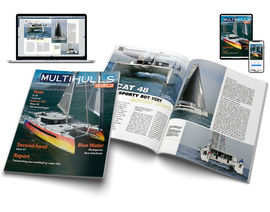
 Discover the 2025 winners!
Discover the 2025 winners! 
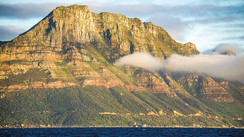
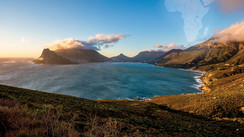
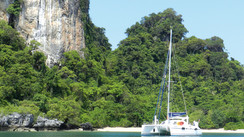
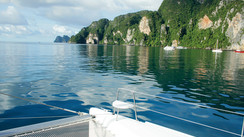
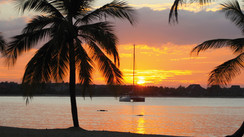
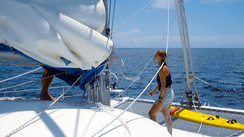







What readers think
Post a comment
No comments to show.